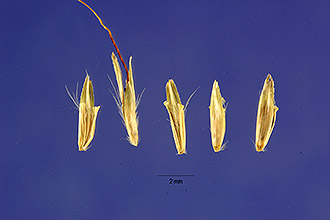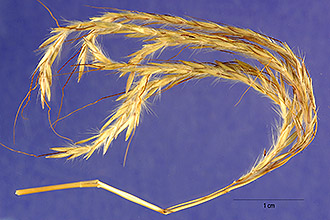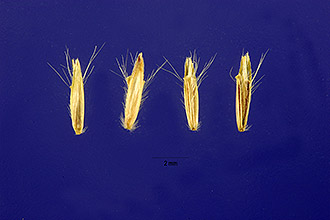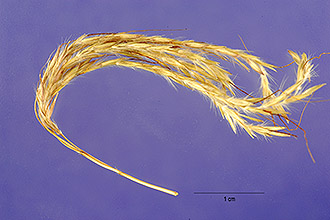Andropogon caucasicus Trin.
Scientific Name: Andropogon caucasicus Trin.

| General Information | |
|---|---|
| Usda Symbol | ANCA20 |
| Group | Monocot |
| Life Cycle | Perennial |
| Growth Habits | Graminoid |
| Native Locations | ANCA20 |
Plant Guide
Use soil moisture sensors to measure the soil moisture of Andropogon caucasicus Trin..
Fact Sheet
Uses
Caucasian bluestem is sometimes used as a critical area cover plant due to its ability to grow on droughty, acid, sterile sites. It should be used in mixtures with native warm season grasses because it is not a particularly valuable wildlife plant. This plant is not reliably hardy north of the PA-NY border. Though used for forage in the southern Midwest, the quality is not high enough to use it in this way in the Northeast.
Status
Please consult the PLANTS Web site and your State Department of Natural Resources for this plant’s current status (e, Use soil moisture sensors to measure the soil moisture of Andropogon caucasicus Trin..,g, threatened or endangered species, state noxious status, and wetland indicator values),
Description
Caucasian bluestem has dense blue-green leaves and thin stems with purple tinges at the nodes. It typically grows to 3-4 feet in height. The seed head is a terminal group of spike-like stalks that come from a common point. The most memorable characteristic is the sweet, distinctive odor of the foliage.
Adaptation and Distribution
Distribution
Distribution
This grass will grow on soils of moderate drainage or better. It will grow well on acid, droughty, and low fertility soils. The best use for this grass is on drastically disturbed sites such as strip mine RAMP sites in PA and South. For a current distribution map, please consult the Plant Profile page for this species on the PLANTS Website.
Establishment
Caucasian bluestem should be seeded as the soil warms in the spring. The germination is slow compared to cool season grasses and the two types of grass are almost never planted together. Native grass drills such as the Truax, Great Plains, or Tye are the best units for planting this seed as they have positive feed mechanisms for chaffy seed and double disk furrow openers. If a suitable drill is not available or cannot be used due to terrain, then broadcasting the seed and tracking it in with a bulldozer is also an excellent planting method. Hydroseeding without tracking is simply a waste of time, money, and effort. Mulches are avoided with warm season grass plantings unless absolutely necessary to control erosion--then use 1500 pounds per acre of straw as a maximum rate. No nitrogen fertilizer should be applied during the seeding year. Phosphorus and potassium should be at medium levels, and the pH should be 5.5 or better on forage fields and 5.0 or better on critical areas. USDA NRCS National Plant Materials Center Beltsville, MD
Plant Traits
Growth Requirements
| Temperature, Minimum (°F) | -23 |
|---|---|
| Adapted to Coarse Textured Soils | No |
| Adapted to Fine Textured Soils | No |
| Adapted to Medium Textured Soils | Yes |
| Anaerobic Tolerance | None |
| CaCO3 Tolerance | Medium |
| Cold Stratification Required | No |
| Drought Tolerance | High |
| Fertility Requirement | High |
| Fire Tolerance | Low |
| Frost Free Days, Minimum | 150 |
| Hedge Tolerance | None |
| Moisture Use | Medium |
| pH, Maximum | 8.0 |
| pH, Minimum | 5.0 |
| Precipitation, Maximum | 50 |
| Precipitation, Minimum | 20 |
| Root Depth, Minimum (inches) | 18 |
| Salinity Tolerance | Low |
| Shade Tolerance | Intolerant |
Morphology/Physiology
| After Harvest Regrowth Rate | Rapid |
|---|---|
| Toxicity | None |
| Shape and Orientation | Semi-Erect |
| Nitrogen Fixation | None |
| Resprout Ability | No |
| Active Growth Period | Summer |
| Bloat | Low |
| C:N Ratio | Medium |
| Coppice Potential | No |
| Fall Conspicuous | No |
| Fire Resistant | No |
| Flower Color | Yellow |
| Flower Conspicuous | No |
| Foliage Color | Green |
| Foliage Porosity Summer | Dense |
| Foliage Texture | Fine |
| Low Growing Grass | No |
| Lifespan | Moderate |
| Leaf Retention | No |
| Known Allelopath | No |
| Height, Mature (feet) | 3.0 |
| Growth Rate | Rapid |
| Growth Form | Bunch |
| Fruit/Seed Conspicuous | No |
| Fruit/Seed Color | Brown |
| Foliage Porosity Winter | Porous |
Reproduction
| Vegetative Spread Rate | Slow |
|---|---|
| Small Grain | No |
| Seedling Vigor | High |
| Seed Spread Rate | Rapid |
| Seed per Pound | 860000 |
| Fruit/Seed Persistence | No |
| Propagated by Tubers | No |
| Propagated by Sprigs | No |
| Propagated by Sod | No |
| Propagated by Seed | Yes |
| Propagated by Corm | No |
| Propagated by Container | No |
| Propagated by Bulb | No |
| Propagated by Bare Root | No |
| Fruit/Seed Period End | Fall |
| Fruit/Seed Period Begin | Summer |
| Fruit/Seed Abundance | Low |
| Commercial Availability | Routinely Available |
| Bloom Period | Mid Summer |
| Propagated by Cuttings | No |
Suitability/Use
| Veneer Product | No |
|---|---|
| Pulpwood Product | No |
| Protein Potential | Low |
| Post Product | No |
| Palatable Human | No |
| Palatable Graze Animal | Low |
| Palatable Browse Animal | Low |
| Nursery Stock Product | No |
| Naval Store Product | No |
| Lumber Product | No |
| Fodder Product | Yes |
| Christmas Tree Product | No |
| Berry/Nut/Seed Product | No |



